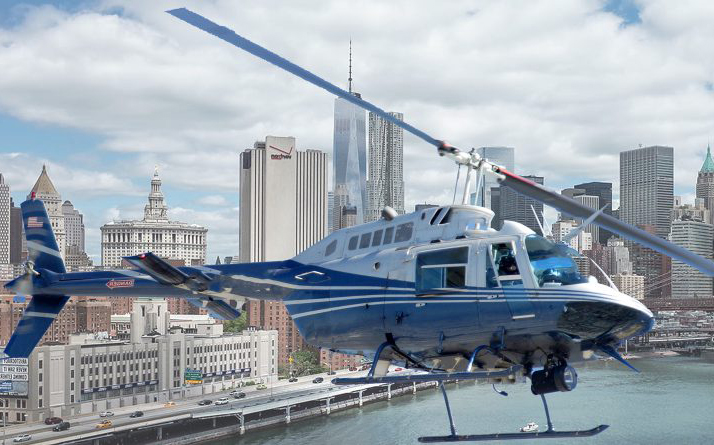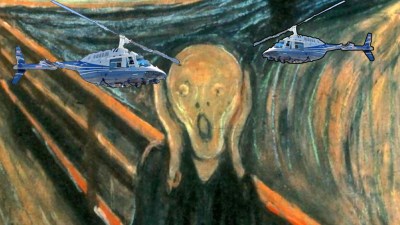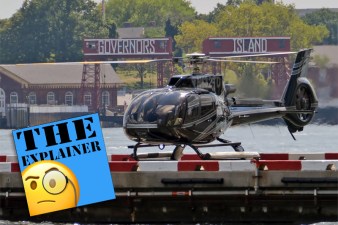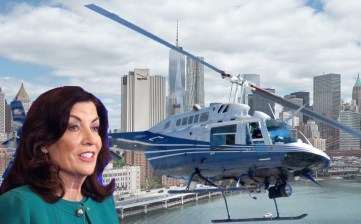KOMANOFF: Don’t Regulate NYC Helicopter Flights, End Them
The following is testimony the author seeks to present at a hearing held by the City Council’s Economic Development Committee on Wednesday at 10 a.m. Hearing details here.
Last fall, a local conservation leader and former city official asked if I might quantify the environmental costs of helicopter flights over New York City. He had in mind a study along the lines of Drowning In Noise: Noise Costs of Jet Skis in America, my 2000 report for the Noise Pollution Clearinghouse that estimated the damages to peace, quiet, safety and clean air from so-called personal watercraft.
I had doubts about the efficacy of such an analysis, given federal pre-emption as well as the lobbying muscle of helicopter interests. I also worried that perhaps my detestation of helicopter noise was just an idiosyncrasy, a quirk shared by few. But I found that my frustration at the continual and sometimes incessant invasion by helicopters of much of the city’s airspace and soundscape is widely held. People despise them. They hate the intrusion helicopters flights cause, the entitlement they embody, the excess and uselessness they connote.

I also found that New Yorkers are dumbfounded at city government’s ostensible helplessness.
Our abhorrence and resentment isn’t reserved for just one category of helicopter flights. It extends to nearly all — tourist flights, commuter flights, news-reporting flights, and, yes, NYPD flights. Aside from the rare, and welcome, rescue mission, each flight type serves only a rarefied, privileged group. Each has alternatives: foot or bus tourism, train or car travel to JFK or the Hamptons, shoe-leather newsgathering, on-the-ground (and less) policing. Each flight intrudes upon thousands of New Yorkers, if not more: in our parks, on our piers, on terraces or rooftops, in our living rooms during the day, in our beds at night.
As I delved into the literature these past few months, I learned of another dimension to helicopters’ assault on our civic well-being. To prevent stalling and to lubricate critical engine parts, some helicopters burn aviation gas fortified with lead.
Aviation gasoline — Avgas, for short — has a lead content of 0.56 grams per liter, which is similar to that of the leaded gasoline that released airborne lead from tailpipes and into American cities, poisoning millions from the 1920s into the 1980s. (See calculation and citations at end of this post.) Children, whose developing brains are particularly vulnerable to cognitive damage from lead-caused reduced oxygen uptake, were especially affected.
Some helicopters in NYC and across the country are burning that stuff, right now. Which makes clear that Intro 2026, which would “prohibit chartered helicopters [apparently commuter] from taking off and landing at heliports owned by the city if those helicopters do not meet the stage 3 noise levels…,” is inadequate, if not downright myopic.
Endeavoring to regulate noise levels for a single category of helicopter flights is a task both Sisyphean (given the inexhaustible legal and engineering resources of helicopter companies vis-a-vis chronically understaffed city agencies) and meager, given that chartered helicopters are just one of several classes of flights that we should be capping, shrinking and eliminating.
Toward that end, I urge the Council to shelve Intro 2026 and the two companion bills Intro 2027 and 2067 and instead undertake a research and legislative campaign with these elements and objectives:
- to terminate as quickly as possible all contracts permitting private helicopter flights from and to city-owned facilities; or to any private airfields within city limits;
- to partner with local authorities and advocates in the New Jersey cities of Kearny, Elizabeth and Linden to stop heliports there from servicing New York City tourist overflights, thereby curbing lead emissions during take-offs and landings and in fuel handling and storage;
- to work with NY and NJ members of Congress to require the Federal Aviation Administration to give full consideration of the adverse impacts of helicopter flights rather than rubber-stamping aviation interests;
- to commission a comprehensive analysis of noise-annoyance and other environmental damage costs from helicopter flights from, to and over the five boroughs;
- to sharply curtail NYPD helicopter deployments for other than exigent, life-saving situations.
Consider what should be a quiet haven for city residents: water-and-sky-kissed, car-free Governors Island. From my home in Tribeca, Governors Island is a quick 1.5-mile bike ride plus short ferry hop. Yet I haven’t gone in years, on account of helicopter noise.
One Monday in June 2015, using my professional sound meter (pictured earlier), I recorded decibel readings at four locations there. They ranged from the high 60s to nearly 81 dB. The omnipresence of helicopter flights made it difficult to obtain background noise levels, but readings taken in their brief absence were around 55 dB.
The 20-plus decibel elevation attributable to the helicopters equates to a four-fold increase in perceived noise. (Any 10-decibel increase translates to a doubling in perceived noise.) As one longtime advocate for Governors Island told me, “One of the great benefits here is that there are no cars, but from an aural perspective that is completely obliterated” by the helicopters.
Quiet isn’t, or shouldn’t be, a luxury. It should be within reach of every New Yorker. I urge the Council to stop dealing away our peace and quiet to a narrow and frivolous special interest. Helicopters have no place in, or above, our great city.
Calculation equating Avgas lead content to leaded gasoline: Avgas’s lead content, 0.56g/liter (per Wikipedia Avgas page, see table under “Grades,” refer to “most commonly used aviation gasoline,” 100LL), equates to 2.12g/gallon. Also see FAA’s 2019 Fact Sheet – Leaded Aviation Fuel and the Environment. The average lead content in gasoline in 1973 was 2-3 grams per gallon, per EPA press release, EPA Takes Final Step in Phaseout of Leaded Gasoline, of Jan. 29, 1996.
Clarification: An earlier version of this story suggested that all helicopters use leaded fuel. It is not all.




